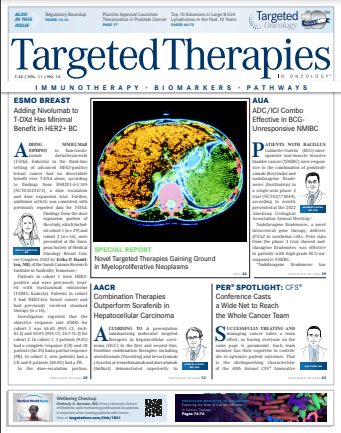Adding Nivolumab to T-DXd Has Minimal Benefit in HER2+ BC
Results from the DS8201-A-U105 study showed that nivolumab added to trastuzumab deruxtecan has some benefit for patients with HER2-positive breast cancer.
Erika P. Hamilton, MD

Adding nivolumab (Opdivo) to fam-trastuzumab deruxtecan-nxki (T-DXd; Enhertu) in the third-line setting of advanced HER2-positive breast cancer had no discernible benefit over T-DXd alone, according to findings from DS8201-A-U105 (NCT03523572), a dose escalation and dose expansion trial. Further, antitumor activity was consistent with previously reported data for T-DXd.
Findings from the dose expansion portion of the study, which included cohort 1 (n = 29) and cohort 2 (n = 16), were presented at the European Society of Medical Oncology Breast Cancer Congress 2022 by Erika P. Hamilton, MD, of the Sarah Cannon Research Institute in Nashville, Tennessee.1
Patients in cohort 1 were HER2- positive and were previously treated with trastuzumab emtansine (T-DM1; Kadcyla). Patients in cohort 2 had HER2-low breast cancer and had previously received standard therapy (n = 16).
Investigators reported that the objective response rate (ORR) for cohort 1 was 65.6% (95% CI, 46.8- 81.4) and 50.0% (95% CI, 24.7-75.3) for cohort 2. In cohort 1, 3 patients (9.4%) had a complete response (CR) and 18 patients (56.3%) had a partial response (PR). In cohort 2, zero patients had a CR and 8 patients (50.0%) had a PR. In the dose-escalation portion, patients received 3.2 mg/kg of T-DXd and 360 mg of nivolumab given once every 3 weeks and 5.4 mg/kg T-DXd and 360 mg of nivolumab given once every 3 weeks.
“Of note, data from 3 patients with HER2- positive breast cancer who received 5.4 mg/kg of T-DXd in combination with 360 mg of nivolumab in part 1 were pooled with the data from patients in cohort 1,” said Hamilton, director of the breast and gynecologic cancer research program at Sarah Cannon Research Institute.
The primary end point for the dose expansion portion was ORR and secondary end points included duration of response (DOR), disease control rate, progression-free survival (PFS), overall survival (OS), and exploratory biomarkers of response. The overall median age was 53.6 years (range, 34.4-76.2; n = 48) and the majority of patients were ECOG performance status 0 (58.3%). Hormonereceptor status was 62.5% positive and 37.5% negative in cohort 1 and 81.2% positive and 18.8% negative in cohort 2. The majority of patients in cohorts 1 and 2 received 4 or more lines of therapy (71.9% and 68.8%, respectively) and 20.8% of patients overall had a history of brain metastases.
In cohort 1, 78.1% of patients had discontinued treatment with T-DXd, whereas 81.3% had discontinued treatment with nivolumab. In cohort 2, 93.8% had discontinued treatment with T-DXd and 100% discontinued nivolumab treatment. The primary reasons for discontinuing either study drug were progressive disease (39.6%) and adverse event (31.3%). The median duration of follow-up was 18.2 months overall (range, 1.7-26.9).
The median PFS was 11.6 months but the median DOR and median OS were not evaluable at data cutoff for cohort 1. In cohort 2, the median PFS was 7.0 months (95% CI, 2.3-10.8 months), median DOR was 5.5 months (95% CI, 2.8-8.0), and median OS was 19.5 months (95% CI, 2.5-not evaluable).
Turning to tumor size reduction, Hamilton said, “the median best percentage change in the sum of the diameters from baseline was 57% in the HER2-positive cohort and 35% in the HER2-low cohort.”
Hamilton continued, “3 patients in the HER2-low cohort, who were hormone receptor-negative did have a confirmed partial response. Furthermore, most patients receiving T-DXd with nivolumab in either cohort experienced a reduction in the sum of tumor diameters from baseline that was sustained over time.”
The median time to respond was 1.6 months and 3.7 months in the HER2-positive and the HER2- low cohorts, respectively.
Regarding safety, all patients experienced at least 1 treatment emergent adverse event (TEAE) or grade 3 or greater TEAE, Hamilton reported.
In cohort 1, 41.4% of patients experienced a serious TEAE and in cohort 2, 25.0% experienced a serious TEAE. Overall, 37.5% of patients experienced a TEAE leading to any study drug discontinuation.
When stratified by drug, TEAEs leading to any study drug discontinuation in cohort 1, 31.0% of patients taking T-DXd discontinued and 24.1% of patients discontinued because of TEAEs from nivolumab. In cohort 2, treatment discontinuation from TEAE related to T-DXd was 12.5% and 18.8% related to nivolumab, respectively. TEAEs leading to nivolumab discontinuation were 48.3% in cohort 1 and 12.5% in cohort 2.
Investigators evaluated adverse events of special interest, including interstitial lung disease (LD) and pneumonitis and left ventricular (LV) dysfunction. Seven patients experienced any grade ILD/pneumonitis and the median time to adjudicated onset was 168 days (range, 40-250). One patient who received 3.2 mg/kg T-DXd in combination with nivolumab in part 1 of the study reported a grade 3 adjudicated drug-related ILD/pneumonitis event. In cohort 1, 2 patients experienced an LV event and no patients in cohort 2 experienced LV dysfunction.
An exploratory biomarker analysis that assessed the ORR by PD-L1 status, IHC status, and tumor cells (TCs) and immune cells (IC) was performed on baseline on new or archival tissue using PD-L1 TC threshold of 1 or greater, PD-L1 IC-positive of 5% or greater, and PD-L1 IC-positive of 1% or greater.
“For both cohorts, a tumor score for PD-L1 expression levels at threshold 1% and an immune cell score at thresholds of 1% or 5% did not reveal differences in ORR,” Hamilton said.
Hamilton concluded that the benefit of adding nivolumab to T-DXd in advanced disease was not discernible in the current study and that adverse events and safety were similar to previous studies. Hamilton cautioned that the findings from the biomarker analysis was based on a small sample size.
REFERENCE:
1. Hamilton E, Shapiro CL, Boni V, et al. Primary analysis from DS8201- A-U105: A 2-part, open-label, phase 1b trial assessing trastuzumab deruxtecan (T-DXd) with nivolumab in patients with HER2-expressing advanced breast cancer. Presented at: European Society of Medical Oncology 2022. May 3-5, 2022. Accessed June 22, 2022. https:// bit.ly/3tSSr2M

Survivorship Care Promotes Evidence-Based Approaches for Quality of Life and Beyond
March 21st 2025Frank J. Penedo, PhD, explains the challenges of survivorship care for patients with cancer and how he implements programs to support patients’ emotional, physical, and practical needs.
Read More